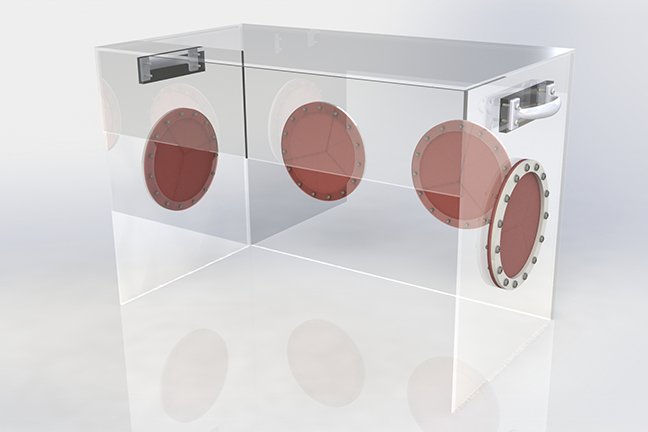University and M Health Fairview roll out protective device for healthcare professionals

Engineering researchers are part of the health care innovation team
MINNEAPOLIS/ST. PAUL (04/28/2020) — The University of Minnesota and M Health Fairview have developed a protection device to minimize exposure to health care providers in clinical settings.
Health care workers — including respiratory therapists, doctors and nurses — participate in procedures where airborne transmission from the patient is possible. This is why health care personnel wear PPE masks, gowns, face shields and other protective gear.
The respiratory protective box prevents transfer of the SARS-CoV-2 virus by limiting the potential for droplets emitted during coughing and sneezing to be transmitted from a patient with COVID-19. This was accomplished by having plastic barriers with armholes between the workers and patient. Thus, see-through box functions as a collection barrier to collect these droplets away from health care workers.
“Physical barriers are effective in collecting cough and sneeze droplets through what we call ‘inertial impaction,’” said Chris Hogan, a mechanical engineering professor in the College of Science and Engineering. “A procedure box should be as effective — or even more effective — than wearing a face shield in this regard, as it puts the barrier closer to the patient and can provide protection for multiple health care providers simultaneously.”
The respiratory protective box, built in collaboration with staff in the College of Science and Engineering machine shop, can be used in respiratory procedures such as intubation, extubation, nebulizer treatments, bronchoscopy and other airway related treatments that occur regularly in the operating rooms and intensive care units. Currently, the respiratory protective box has been distributed to M Health Fairview hospitals.
“The respiratory procedure box provides an additional layer of safety for our clinicians on the front lines,” said Gwenyth Fischer, an assistant professor in the Medical School on the Twin Cities campus and a pediatrician at M Health Fairview.
This research was funded by the Rapid Response Grants from the U of M Office of Academic Clinical Affairs (OACA). The M Health Fairview and U of M team is affiliated with the University’s Institute for Engineering in Medicine, College of Science and Engineering, Medical School and M Simulation.
